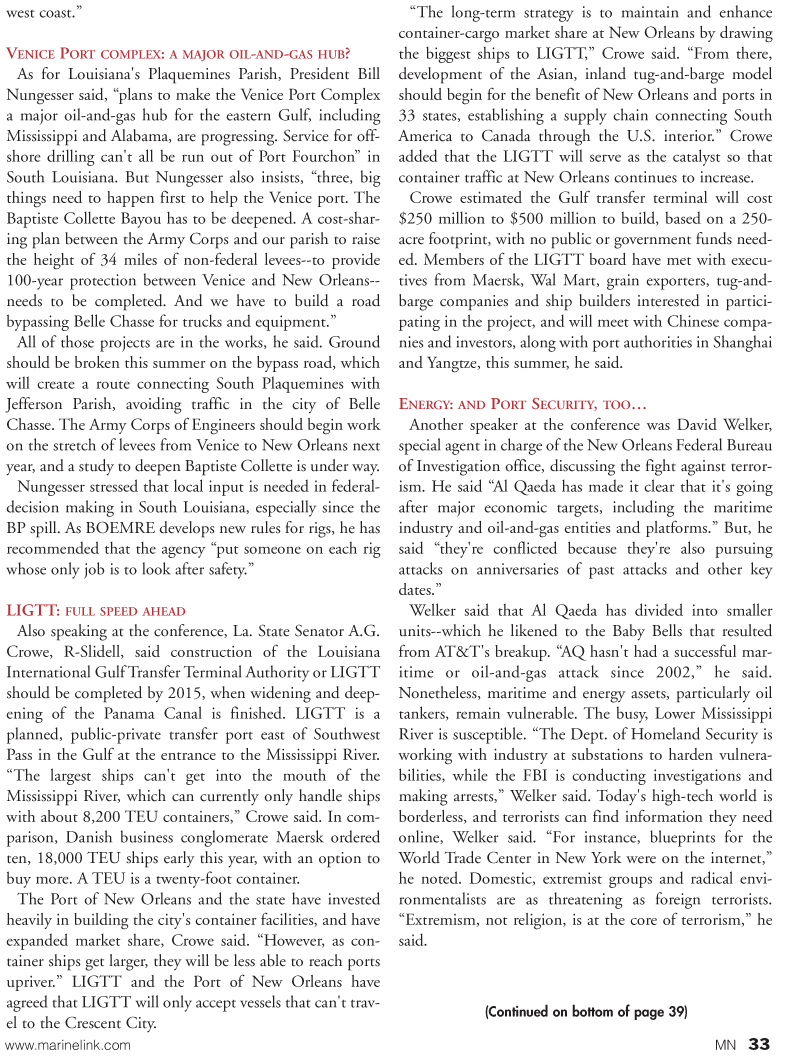
Page 33: of Marine News Magazine (August 2011)
Marine Salvage & Recovery Edition
Read this page in Pdf, Flash or Html5 edition of August 2011 Marine News Magazine
west coast.? VENICEPORTCOMPLEX : AMAJOROIL -AND-GASHUB ?As for Louisiana's Plaquemines Parish, President Bill Nungesser said, plans to make the Venice Port Complex a major oil-and-gas hub for the eastern Gulf, including Mississippi and Alabama, are progressing. Service for off- shore drilling can't all be run out of Port Fourchon? in South Louisiana. But Nungesser also insists, three, big things need to happen first to help the Venice port. The Baptiste Collette Bayou has to be deepened. A cost-shar- ing plan between the Army Corps and our parish to raise the height of 34 miles of non-federal levees--to provide 100-year protection between Venice and New Orleans-- needs to be completed. And we have to build a road bypassing Belle Chasse for trucks and equipment.? All of those projects are in the works, he said. Ground should be broken this summer on the bypass road, which will create a route connecting South Plaquemines with Jefferson Parish, avoiding traffic in the city of Belle Chasse. The Army Corps of Engineers should begin work on the stretch of levees from Venice to New Orleans next year, and a study to deepen Baptiste Collette is under way. Nungesser stressed that local input is needed in federal- decision making in South Louisiana, especially since the BP spill. As BOEMRE develops new rules for rigs, he has recommended that the agency put someone on each rig whose only job is to look after safety.? LIGTT: FULLSPEEDAHEAD Also speaking at the conference, La. State Senator A.G. Crowe, R-Slidell, said construction of the Louisiana International Gulf Transfer Terminal Authority or LIGTT should be completed by 2015, when widening and deep- ening of the Panama Canal is finished. LIGTT is a planned, public-private transfer port east of Southwest Pass in the Gulf at the entrance to the Mississippi River. The largest ships can't get into the mouth of the Mississippi River, which can currently only handle ships with about 8,200 TEU containers,? Crowe said. In com- parison, Danish business conglomerate Maersk ordered ten, 18,000 TEU ships early this year, with an option to buy more. A TEU is a twenty-foot container. The Port of New Orleans and the state have invested heavily in building the city's container facilities, and have expanded market share, Crowe said. However, as con- tainer ships get larger, they will be less able to reach ports upriver.? LIGTT and the Port of New Orleans have agreed that LIGTT will only accept vessels that can't trav- el to the Crescent City. The long-term strategy is to maintain and enhance container-cargo market share at New Orleans by drawing the biggest ships to LIGTT,? Crowe said. From there, development of the Asian, inland tug-and-barge model should begin for the benefit of New Orleans and ports in 33 states, establishing a supply chain connecting South America to Canada through the U.S. interior.? Crowe added that the LIGTT will serve as the catalyst so that container traffic at New Orleans continues to increase. Crowe estimated the Gulf transfer terminal will cost $250 million to $500 million to build, based on a 250-acre footprint, with no public or government funds need- ed. Members of the LIGTT board have met with execu- tives from Maersk, Wal Mart, grain exporters, tug-and- barge companies and ship builders interested in partici- pating in the project, and will meet with Chinese compa- nies and investors, along with port authorities in Shanghai and Yangtze, this summer, he said. ENERGY : ANDPORT SECURITY , TOO ?Another speaker at the conference was David Welker, special agent in charge of the New Orleans Federal Bureau of Investigation office, discussing the fight against terror- ism. He said Al Qaeda has made it clear that it's going after major economic targets, including the maritimeindustry and oil-and-gas entities and platforms.? But, he said they're conflicted because they're also pursuing attacks on anniversaries of past attacks and other key dates.? Welker said that Al Qaeda has divided into smaller units--which he likened to the Baby Bells that resulted from AT&T's breakup. AQ hasn't had a successful mar- itime or oil-and-gas attack since 2002,? he said.Nonetheless, maritime and energy assets, particularly oil tankers, remain vulnerable. The busy, Lower Mississippi River is susceptible. The Dept. of Homeland Security is working with industry at substations to harden vulnera- bilities, while the FBI is conducting investigations and making arrests,? Welker said. Today's high-tech world is borderless, and terrorists can find information they need online, Welker said. For instance, blueprints for the World Trade Center in New York were on the internet,? he noted. Domestic, extremist groups and radical envi- ronmentalists are as threatening as foreign terrorists. Extremism, not religion, is at the core of terrorism,? he said.www.marinelink.com MN33(Continued on bottom of page 39)

 32
32

 34
34
